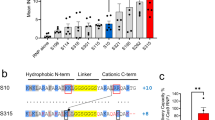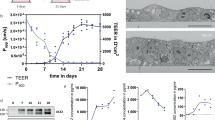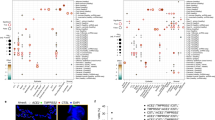Abstract
Adeno-associated virus (AAV) has been investigated to transfer the cystic fibrosis transmembrane conductance regulator (CFTR) to airways. Inhaled AAV2-CFTR in people with cystic fibrosis (CF) is safe, but inefficient. In vitro, AAV2 transduction of human airway epithelia on the apical (luminal) side is inefficient, but efficient basolaterally. We previously selected AAV2.5T, a novel capsid that apically transduces CF human airway epithelia and efficiently restores CFTR function. We hypothesize the AAV receptor (AAVR) is basolaterally localized, and that AAV2.5T utilizes an alternative apical receptor. We found AAVR in human airway epithelia by western blot and RNA-Seq analyses. Using immunocytochemistry we did not find endogenous AAVR at membranes but overexpression localized AAVR to the basolateral membrane, where it preferentially increased transduction. Anti-AAVR antibodies blocked transduction by AAV2 from the basolateral side but not AAV2.5T from the apical side, suggesting a unique apical receptor. Finally, we found infection by AAV2 but not AAV2.5T was blocked by CRISPR knockout of AAVR in cell lines. Our data suggest the absence of apical AAVR is rate limiting for AAV2, and efficient transduction by AAV2.5T is accomplished using an AAVR independent pathway. Our findings inform the development of gene therapy for CF, and AAV vectors in general.
This is a preview of subscription content, access via your institution
Access options
Subscribe to this journal
Receive 12 print issues and online access
$259.00 per year
only $21.58 per issue
Buy this article
- Purchase on Springer Link
- Instant access to full article PDF
Prices may be subject to local taxes which are calculated during checkout







Similar content being viewed by others
References
Griesenbach U, Alton EW. Moving forward: cystic fibrosis gene therapy. Hum Mol Genet. 2013;22(R1):R52–58.
Griesenbach U, Alton EW. Progress in gene and cell therapy for cystic fibrosis lung disease. Curr Pharma Design. 2012;18:642–62.
Welsh MJ. Gene transfer for cystic fibrosis. J Clin Invest. 1999;104:1165–6.
Steines B, Dickey DD, Bergen J, Excoffon KJ, Weinstein JR, Li X et al. CFTR gene transfer with AAV improves early cystic fibrosis pig phenotypes. JCI Insight. 2016;1:e88728.
Excoffon KJ, Koerber JT, Dickey DD, Murtha M, Keshavjee S, Kaspar BK et al. Directed evolution of adeno-associated virus to an infectious respiratory virus. Proc Natl Acad Sci USA. 2009;106:3865–70.
Yan Z, Sun X, Feng Z, Li G, Fisher JT, Stewart ZA et al. Optimization of recombinant adeno-associated virus-mediated expression for large transgenes, using a synthetic promoter and tandem array enhancers. Hum Gene Ther. 2015;26:334–46.
Flotte TR, Afione SA, Zeitlin PL. Adeno-associated virus vector gene expression occurs in nondividing cells in the absence of vector DNA integration. Am J Resp Cell Mol Biol. 1994;11:517–21.
Moss RB, Milla C, Colombo J, Accurso F, Zeitlin PL, Clancy JP et al. Repeated aerosolized AAV-CFTR for treatment of cystic fibrosis: a randomized placebo-controlled phase 2B trial. Hum Gene Ther. 2007;18:726–32.
Moss RB, Rodman D, Spencer LT, Aitken ML, Zeitlin PL, Waltz D et al. Repeated adeno-associated virus serotype 2 aerosol-mediated cystic fibrosis transmembrane regulator gene transfer to the lungs of patients with cystic fibrosis: a multicenter, double-blind, placebo-controlled trial. Chest. 2004;125:509–21.
Aitken ML, Moss RB, Waltz DA, Dovey ME, Tonelli MR, McNamara SC et al. A phase I study of aerosolized administration of tgAAVCF to cystic fibrosis subjects with mild lung disease. Hum Gene Ther. 2001;12:1907–16.
Virella-Lowell I, Zusman B, Foust K, Loiler S, Conlon T, Song S et al. Enhancing rAAV vector expression in the lung. J Gene Med. 2005;7:842–50.
Guggino WB, Cebotaru L. Adeno-Associated Virus (AAV) gene therapy for cystic fibrosis: current barriers and recent developments. Exp Opin Biol Ther. 2017;17:1265–73.
Sanders N, Rudolph C, Braeckmans K, De Smedt SC, Demeester J. Extracellular barriers in respiratory gene therapy. Adv Drug Deliv Rev. 2009;61:115–27.
Zincarelli C, Soltys S, Rengo G, Rabinowitz JE. Analysis of AAV serotypes 1-9 mediated gene expression and tropism in mice after systemic injection. Mol Ther. 2008;16:1073–80.
Mizukami H, Young NS, Brown KE. Adeno-associated virus type 2 binds to a 150-kilodalton cell membrane glycoprotein. Virology. 1996;217:124–30.
Kashiwakura Y, Tamayose K, Iwabuchi K, Hirai Y, Shimada T, Matsumoto K et al. Hepatocyte growth factor receptor is a coreceptor for adeno-associated virus type 2 infection. J Virol. 2005;79:609–14.
Qing K, Mah C, Hansen J, Zhou S, Dwarki V, Srivastava A. Human fibroblast growth factor receptor 1 is a co-receptor for infection by adeno-associated virus 2. Nat Med. 1999;5:71–7.
Summerford C, Bartlett JS, Samulski RJ. AlphaVbeta5 integrin: a co-receptor for adeno-associated virus type 2 infection. Nat Med. 1999;5:78–82.
Summerford C, Samulski RJ. Membrane-associated heparan sulfate proteoglycan is a receptor for adeno-associated virus type 2 virions. J Virol. 1998;72:1438–45.
Seiler MP, Miller AD, Zabner J, Halbert CL. Adeno-associated virus types 5 and 6 use distinct receptors for cell entry. Hum Gene Ther. 2006;17:10–19.
Wu Z, Miller E, Agbandje-McKenna M, Samulski RJ. α2,3 and α2,6 N-linked sialic acids facilitate efficient binding and transduction by adeno-associated virus types 1 and 6. J Virol. 2006;80:9093–103.
Walters RW, Yi SM, Keshavjee S, Brown KE, Welsh MJ, Chiorini JA et al. Binding of adeno-associated virus type 5 to 2,3-linked sialic acid is required for gene transfer. J Biol Chem. 2001;276:20610–6.
Kaludov N, Brown KE, Walters RW, Zabner J, Chiorini JA. Adeno-associated virus serotype 4 (AAV4) and AAV5 both require sialic acid binding for hemagglutination and efficient transduction but differ in sialic acid linkage specificity. J Virol. 2001;75:6884–93.
Bell CL, Vandenberghe LH, Bell P, Limberis MP, Gao GP, Van Vliet K et al. The AAV9 receptor and its modification to improve in vivo lung gene transfer in mice. J Clin Invest. 2011;121:2427–35.
Pillay S, Meyer NL, Puschnik AS, Davulcu O, Diep J, Ishikawa Y et al. An essential receptor for adeno-associated virus infection. Nature. 2016;530:108–12.
Pillay S, Zou W, Cheng F, Puschnik AS, Meyer NL, Ganaie SS et al. AAV serotypes have distinctive interactions with domains of the cellular receptor AAVR. J Virol. 2017;91:00391–17.
Poon MW, Tsang WH, Waye MM, Chan SO. Distribution of Kiaa0319-like immunoreactivity in the adult mouse brain--a novel protein encoded by the putative dyslexia susceptibility gene KIAA0319-like. Histol Histopathol. 2011;26:953–63.
Platt MP, Adler WT, Mehlhorn AJ, Johnson GC, Wright KA, Choi RT et al. Embryonic disruption of the candidate dyslexia susceptibility gene homolog Kiaa0319-like results in neuronal migration disorders. Neuroscience. 2013;248:585–93.
Bhella D. The role of cellular adhesion molecules in virus attachment and entry. Philos Trans R Soc Lond B Biol Sci. 2015;370:20140035.
Karp PH, Moninger TO, Weber SP, Nesselhauf TS, Launspach JL, Zabner J et al. An in vitro model of differentiated human airway epithelia. Methods for establishing primary cultures. Methods Mol Biol (Clifton, N.J.). 2002;188:115–37.
Ran FA, Hsu PD, Wright J, Agarwala V, Scott DA, Zhang F. Genome engineering using the CRISPR-Cas9 system. Nat Protocol. 2013;8:2281–308.
Flotte TR, Solow R, Owens RA, Afione S, Zeitlin PL, Carter BJ. Gene expression from adeno-associated virus vectors in airway epithelial cells. Am J Resp Cell Mol Biol. 1992;7:349–56.
Griesenbach U, Alton EW. Current status and future directions of gene and cell therapy for cystic fibrosis. BioDrugs. 2011;25:77–88.
Zabner J, Seiler M, Walters R, Kotin RM, Fulgeras W, Davidson BL et al. Adeno-associated virus type 5 (AAV5) but not AAV2 binds to the apical surfaces of airway epithelia and facilitates gene transfer. J Virol. 2000;74:3852–8.
Walters RW, Duan D, Engelhardt JF, Welsh MJ. Incorporation of adeno-associated virus in a calcium phosphate coprecipitate improves gene transfer to airway epithelia in vitro and in vivo. J Virol. 2000;74:535–40.
Uhlén MFL, Hallström BM, Lindskog C, Oksvold P, Mardinoglu A, Sivertsson Å et al. The human protein atlas. Mol Cell Proteomics. 2005;4:1920–32.
Pezzulo AA, Tudas RA, Stewart CG, Buonfiglio LGV, Lindsay BD, Taft PJ et al. HSP90 inhibitor geldanamycin reverts IL-13- and IL-17-induced airway goblet cell metaplasia. J Clin Invest. 2019;129:744-758.
Duan D, Yue Y, Yan Z, McCray PB Jr., Engelhardt JF. Polarity influences the efficiency of recombinant adenoassociated virus infection in differentiated airway epithelia. Hum Gene Ther. 1998;9:2761–76.
Duan D, Yue Y, Yan Z, Yang J, Engelhardt JF. Endosomal processing limits gene transfer to polarized airway epithelia by adeno-associated virus. J Clin Invest. 2000;105:1573–87.
Boyle MP, Enke RA, Reynolds JB, Mogayzel PJ Jr., Guggino WB, Zeitlin PL. Membrane-associated heparan sulfate is not required for rAAV-2 infection of human respiratory epithelia. Virol J. 2006;3:29.
Walters RW, Grunst T, Bergelson JM, Finberg RW, Welsh MJ, Zabner J. Basolateral localization of fiber receptors limits adenovirus infection from the apical surface of airway epithelia. J Biol Chem. 1999;274:10219–26.
Dudek AM, Pillay S, Puschnik AS, Nagamine CM, Cheng F, Qiu J et al. An alternate route for adeno-associated virus entry independent of AAVR. J Virol. 2018;92:1–15.
Lee H, Lotery A. Gene therapy for RPE65-mediated inherited retinal dystrophy completes phase 3. Lancet (London, England). 2017;390:823–4.
Carroll J. FDA experts offer a unanimous endorsement for pioneering gene therapy for blindness. Science Magazine: Science; 13 October, 2017.
Qing K, Bachelot T, Mukherjee P, Wang XS, Peng L, Yoder MC et al. Adeno-associated virus type 2-mediated transfer of ecotropic retrovirus receptor cDNA allows ecotropic retroviral transduction of established and primary human cells. J Virol. 1997;71:5663–7.
Wickham TJ, Roelvink PW, Brough DE, Kovesdi I. Adenovirus targeted to heparan-containing receptors increases its gene delivery efficiency to multiple cell types. Nat Biotechnol. 1996;14:1570–3.
Bartlett JS, Kleinschmidt J, Boucher RC, Samulski RJ. Targeted adeno-associated virus vector transduction of nonpermissive cells mediated by a bispecific F(ab’gamma)2 antibody. Nat Biotechnol. 1999;17:181–6.
Dickey DD, Excoffon KJ, Koerber JT, Bergen J, Steines B, Klesney-Tait J et al. Enhanced sialic acid-dependent endocytosis explains the increased efficiency of infection of airway epithelia by a novel adeno-associated virus. J Virol. 2011;85:9023–30.
Acknowledgements
This work was supported by grants from the NIH (H678200-G) and the University of Iowa Center for Gene Therapy (DK054759).
Author information
Authors and Affiliations
Corresponding author
Ethics declarations
Conflict of interest
Dr. Zabner is a founder and holds equity in TaleeBio. The other authors declare that they have no conflict of interest.
Additional information
Publisher’s note: Springer Nature remains neutral with regard to jurisdictional claims in published maps and institutional affiliations.
Rights and permissions
About this article
Cite this article
Hamilton, B.A., Li, X., Pezzulo, A.A. et al. Polarized AAVR expression determines infectivity by AAV gene therapy vectors. Gene Ther 26, 240–249 (2019). https://doi.org/10.1038/s41434-019-0078-3
Received:
Revised:
Accepted:
Published:
Issue Date:
DOI: https://doi.org/10.1038/s41434-019-0078-3
This article is cited by
-
Serotype-specific transduction of canine joint tissue explants and cultured monolayers by self-complementary adeno-associated viral vectors
Gene Therapy (2023)
-
Tissue and cell-type-specific transduction using rAAV vectors in lung diseases
Journal of Molecular Medicine (2021)



